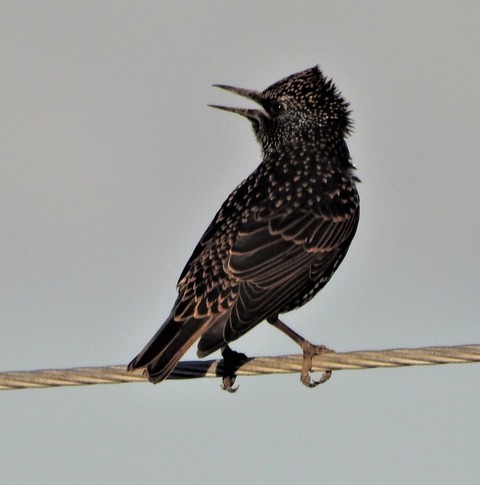“I Will Survive” could easily be the anthem of this wise and most resourceful European immigrant.
This glittery, short-tailed, long-beaked bird is not supposed to be here—but it is, and has been for over a hundred years, through no fault of its own. Our own resident populations—joined by thousands of their northerly fellows, plus great-tailed grackles, various pigeons, doves and others—noisily crowd our electrical wires close to sunset, looking like a musical staff chock full of quarter notes, tails wagging in the breeze.
Especially in wintertime, starlings, sometimes thousands of them, create spectacular murmurations—patterns of mass swooping, with birds forming ever-changing swirls of black and gray. This is likely for protection—to befuddle falcons and hawks—and perhaps for warmth. Even in a huge whirl, each bird appears to react to the motions of only six or seven of its nearby kin, resulting in few accidents.
In 1890 and 1891, Eugene Schieffelin, president of the American Acclimatization Society, famously released a hundred European starlings into Central Park. (Acclimatizing, or experimentally releasing species endemic to other countries, was quite the thing back then). Schieffelin did not—contrary to an oft-repeated yarn—strive to populate our country with all of Shakespeare’s birds, as current research demonstrates.
This now debunked rumor (one I myself have spread!) has an interesting origin, one which will ring true with anyone who follows current news. Edwin Way Teale, an esteemed nineteenth century nature writer, merely mused about this possibility, and the media took it from there. Also, no evidence exists that Schieffelin was a particular fan of Shakespeare—who mentioned starlings only once, in reference to their talents at mockery, in Henry IV Part II, when the character Hotspur muses about training a starling to say nothing to the king but the name of his enemy, Mortimer.
European starlings rapidly populated North America, adapting to whatever circumstances they found. Now they number an estimated 60 to 200 million (though they, like other birds, are in some decline).
The European starling—in the same family, Sturnidae, as the well-known mimic, the myna— employs a vast array of songs and calls, and both males and females mimic other birds, cats, mechanical sounds and human speech. People once kept these talented mimics as caged pets. Mozart, according to his personal notebooks, owned a starling, whose death he mourned deeply. Some musicologists have wondered if this starling’s songs inspired some of his own pieces, most notably a confounding piece entitled “The Musical Joke”. Starlings’ flair for mimicry—as is perhaps the case with mimids like mockingbirds, catbirds and thrashers—may burnish their attraction as spunky and healthy mates.
Favorable to its endurance is the European starling’s broad, diverse diet, including worms, spiders and insects—some of which it plucks from mammals’ fur— seeds, grains, fruits, flowers, pet food, scraps, and, to the distress of farmers, livestock feed. Starlings—sometimes thousands of them— may forage in flocks, often alongside species with common interests, including grackles, cowbirds and sparrows. Able to detect some odors, starlings also have a highly developed sense of taste. A foraging starling frequently inserts its open bill into soil to detect and capture prey.
Environmental degradation and fragmentation spell loss for many species, but not so much for starlings—which thrive in parks, pastures and lots. Cavity-nesting starlings, accused of evicting woodpeckers and a few others from nests, appear not to disturb forest-dwelling species.
Besides stealing cavities from other birds, starlings nest in openings in buildings and boxes and may dig holes in sand or soft rocks, though they prefer the protective branches of trees. They fill their nests with pine needles, twigs, feathers, paper, plastic and hair—all readily obtained. Cowbirds, which deposit their eggs in the nests of other birds, rarely prey upon starlings, who mount a vigorous defense.
Though strict requirements govern the capture or killing of birds, the starling, as an invasive, is exempt. Starlings raid livestock feed, possibly spreading diseases. In fact, the USDA’s Wildlife Services program will help people disperse, relocate or kill them. Starlings may contribute to the decline of some cavity-nesting birds. Masses of starlings—along with, most notably, vultures and geese—have caused fatal airline crashes. In 1960, starlings, engulfed by propellers, caused an airplane to pitch left, then crash into Boston Harbor, killing 62 of its 70 passengers. Pilots are trained for this possibility, and airports take actions such as pruning nearby trees, closing hangars near sunrise and sunset and allowing grass to grow to a height discomfiting to wary birds, constantly on the lookout for predators. Starlings are indeed problematic. But they appear to be our permanent guests, and they, like others of our fellow creatures, amaze and fascinate us.

